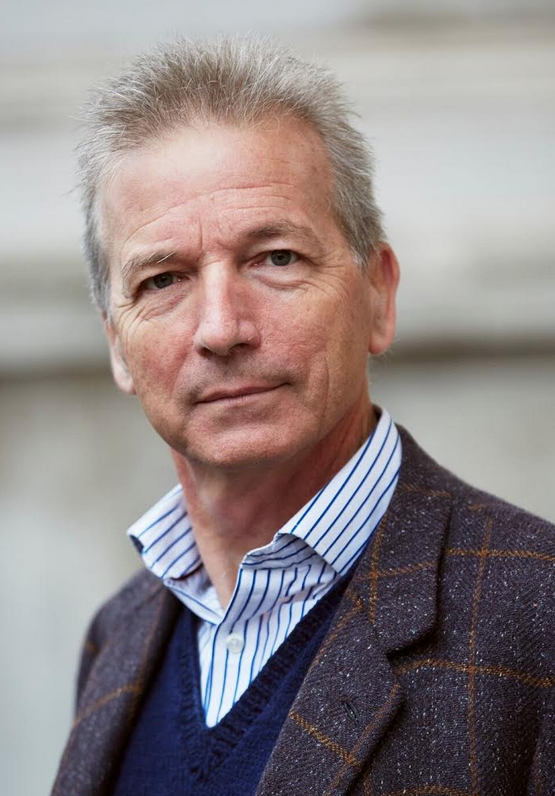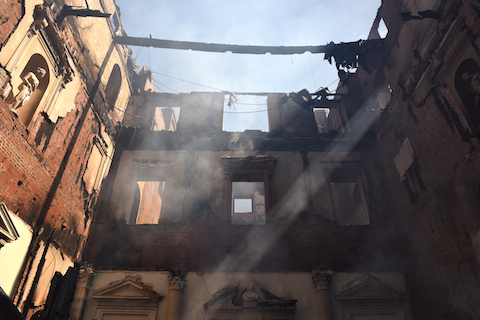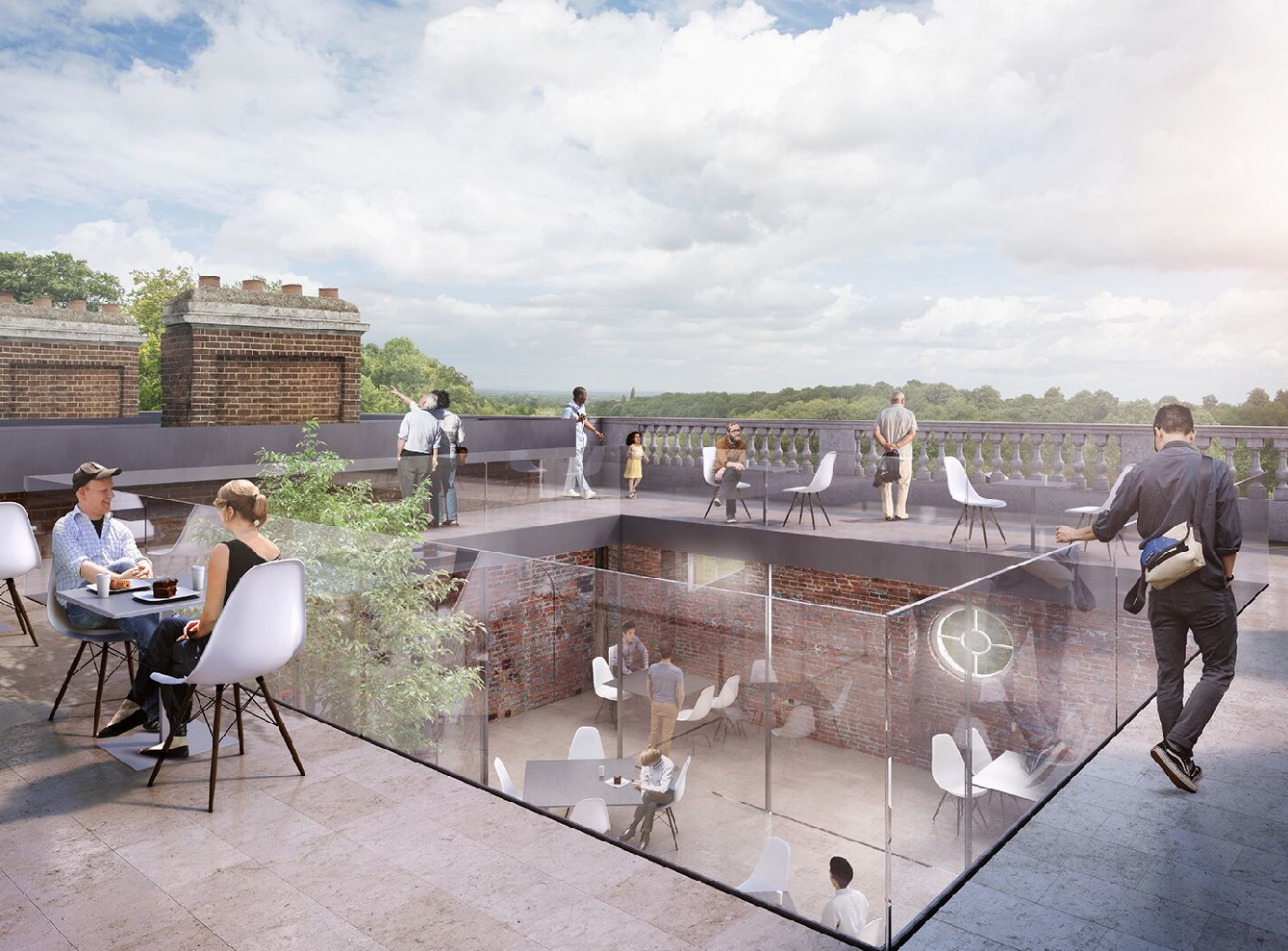 Abraham Lincoln
If given the truth, the people can be depended upon to meet any national crisis...
Abraham Lincoln
If given the truth, the people can be depended upon to meet any national crisis...
 Guildford news...
for Guildford people, brought to you by Guildford reporters - Guildford's own news service
Guildford news...
for Guildford people, brought to you by Guildford reporters - Guildford's own news service
Dragon Interview: Clive Aslet – Clandon Park International Design Competition Jury Member
Published on: 17 Dec, 2017
Updated on: 18 Dec, 2017
The restoration proposals from Allies & Morrison for Clandon Park have proved, perhaps unsurprisingly, controversial. So how did the Clandon Park International Design Competition “jury” come to their decision. Martin Giles put some questions to one of the jury members, Clive Aslet, an author on architectural history, journalist and former editor of Country Life:
How did you come to be on the jury to select the design for Clandon Park’s restoration?
I’m an architectural historian and have written a lot about country houses of all kinds, not least during the many years I spent at Country Life, 13 of which were as editor. I’ve followed the various debates about the National Trust and sometimes commented in The Times and elsewhere.
It was a balanced jury, under the excellent chairmanship of Sandy Nairn, who used to be head of the National Portrait Gallery. Local opinion was represented by Penelope Keith, and other people had special expertise in architecture, conservation and museum display.
What did you think of the standard of entries? Did you enjoy the selection process?
There was a very high standard of entries which made the judging both enjoyable and exhausting. We had to interrogate each entry very closely, and there were many factors to consider – the landscape as well as the conservation of the house, for example. It’s an unusual project because the fire was so intense, starting in the basement and consuming much of the house.
Visiting the house with the other jury members was thrilling. It is extraordinary to go up to the roof and look down into the cavernous voids. You realise how big Clandon is – also how it relates to Guildford and London, both of which are just about visible.
What persuaded you that the Allies and Morrison design was the best?
All the architects and conservation teams spoke with passion, and that was certainly true of Allies and Morrison. We felt that they understood the house. It’s amazing that, after such a violent fire, it’s possible to restore rooms such as the Marble Hall – which of course isn’t marble at all, except for the floor, but stucco. There are some areas, however, which it simply isn’t possible to restore – yes, they could be recreated in facsimile, but we didn’t see much point in that.
some areas… could be recreated in facsimile, but we didn’t see much point in that.
The spaces opened up by the fire are exciting in themselves, and offer the opportunity to give a new purpose to the house. It can’t be a house to live in, anymore – but it can become a centre of a different kind of life. Allies and Morrison seemed to respond to this most sensitively.
Their proposed scheme allows visitors to get onto the roof which, if it goes ahead, will be glorious. I hope they’ll take away the Victorian porte-cochere, because the fire has had the virtue of burning away all the later additions, made in the 19th century, so Clandon has been stripped back to something akin to the house Leoni left – its bones anyway.
What would you say to those, including the Earl of Onslow, who have expressed disappointment with the proposed design and think that either a full restoration should be carried out or that the house should be left as a ruin?
It would be highly unsatisfactory to leave Clandon as a ruin. Buildings need to be used. Life is being breathed back into this one, in a way that won’t make it better than before, but will certainly be different. What would anyone do with a ruin?
Although remarkable to visit in its present state, I think most National Trust members would find it pretty grim – and then there would be the problem of stabilising the walls. Fortunately, Clandon was insured, but the insurance money can only be spent on rebuilding.
What would anyone do with a ruin?
I don’t think it’s sensible to restore the property to its condition before the fire because the fire wiped out part of it so completely that it would be meaningless. A surprising amount of plasterwork survives in the most richly decorated rooms, but the others were destroyed completely. The fire at Uppark started in the roof – and that was bad enough. But Clandon was even worse because the fire originated in a basement. So in some rooms, there isn’t anything to restore – it would be a matter of reproducing what previously existed in facsimile.
That could be done but Allies and Morrison are proposing something new and, to my mind, better. The house wasn’t very much visited before the fire – now it will become a real focus of interest for the community, with exhibitions that will attract visitors from London. It’s just what the National Trust should be doing.
Were the Earl’s views known before the decision was taken?
Yes, Lord Onslow’s views had been fairly well publicised. I can see that from his point of view a ruin would be preferable, since he owns the park. Why would he want to encourage visitors? A quiet ruin would probably be very nice from his point of view. It’s different for the National Trust.
Will you be a regular visitor once the work is completed?
I certainly look forward to the work being done, and I shall certainly visit. If there is a good programme of exhibitions, I can easily imagine myself visiting regularly. I suspect, in a smaller way, it will become a bit like Tate Modern – a brilliantly successful new museum in the shell of an old building.
See also earlier article: Clandon Park – Earl Unhappy With Winning Restoration Design Concept
Responses to Dragon Interview: Clive Aslet – Clandon Park International Design Competition Jury Member
Leave a Comment Cancel replyPlease see our comments policy. All comments are moderated and may take time to appear.

"Found any?" - "Nope, it all looks green to me!" (See Opinion: The Future is Congested, the Future is Grey)
www.abbotshospital.org/news/">





Recent Articles
- Latest Evidence in Sara Sharif Trial
- Ash’s New Road Bridge Is Named – and November 23rd Is Opening Day
- Class A in Underwear Leads to Jail Sentence
- Historical Almshouse Charity Celebrates Guildford in Bloom Victory
- Notice: Shalford Renewable Showcase – November 16
- Firework Fiesta: Guildford Lions Club Announces Extra Attractions
- Come and Meet the Flower Fairies at Watts Gallery
- Updated: Royal Mail Public Counter in Woodbridge Meadows to Close, Says Staff Member
- Letter: New Developments Should Benefit Local People
- Open Letter to Jeremy Hunt, MP: Ash’s Healthcare Concerns


Recent Comments
- Paul Spooner on Ash’s New Road Bridge Is Named – and November 23rd Is Opening Day
- Harry Eve on Opinion: The Future is Congested, the Future is Grey
- Nigel Keane on Letter: New Developments Should Benefit Local People
- Nathan Cassidy on Updated: Royal Mail Public Counter in Woodbridge Meadows to Close, Says Staff Member
- T Saunders on Opinion: The Future is Congested, the Future is Grey
- Jim Allen on Updated: Royal Mail Public Counter in Woodbridge Meadows to Close, Says Staff Member
Search in Site
Media Gallery
Dragon Interview: Local Artist Leaves Her Mark At One of England’s Most Historic Buildings
January 21, 2023 / No Comment / Read MoreDragon Interview: Lib Dem Planning Chair: ‘Current Policy Doesn’t Work for Local People’
January 19, 2023 / No Comment / Read MoreA3 Tunnel in Guildford ‘Necessary’ for New Homes, Says Guildford’s MP
January 10, 2023 / No Comment / Read More‘Madness’ for London Road Scheme to Go Ahead Against ‘Huge Opposition’, Says SCC Leader
January 6, 2023 / No Comment / Read MoreCouncillor’s Son Starts Campaign for More Consultation on North Street Plan
December 30, 2022 / No Comment / Read MoreCounty Council Climbs Down Over London Road Works – Further ‘Engagement’ Period Announced
December 14, 2022 / No Comment / Read MoreDragon Interview: GBC Reaction to the Government’s Expected Decision to Relax Housing Targets
December 7, 2022 / No Comment / Read MoreHow Can Our Town Centre Businesses Recover? Watch the Shop Front Debate
May 18, 2020 / No Comment / Read More











The Earl of Onslow
December 18, 2017 at 11:47 am
Buildings are not organic and therefore for cannot grow.
Buildings are designed to be complete so when completely destroyed (bar 10%) there is nothing of substance to evolve or revitalise.
It is the purpose of the NT to breath life into our history not attempt to create it by making exhibition centres.
John Perkins
December 18, 2017 at 6:35 pm
I quite agree; the function of the NT was to preserve the old building. Having failed to do so they no longer have much purpose.
David Roberts
December 20, 2017 at 6:16 pm
“What would anyone do with a ruin?” is an outrageous question for a supposed architectural historian to ask. For millennia, people have flocked to see the ruins of ancient Greece, Rome and other civilisations. At various periods, they have gone to great lengths to re-create them, or even build new ones.
The Romantics understood better than the National Trust apparently does the uplifting emotions an artfully maintained ruin can evoke. Just visit Painshill Park in Cobham.
Maybe a stint as a full-time hermit at Clandon Park would cure Mr Aslet of his dated love affair with Modernism.